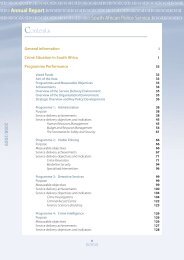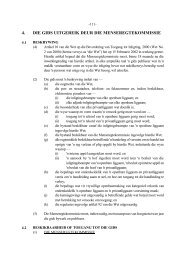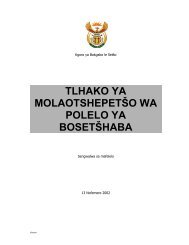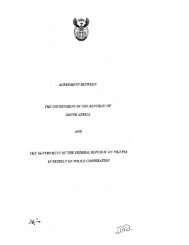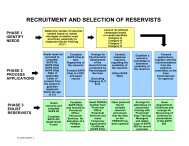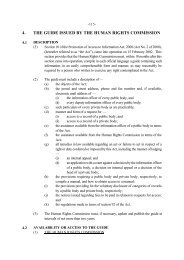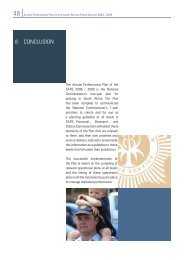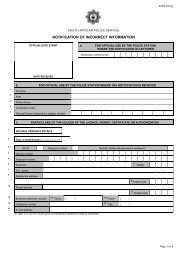Part 13 - Saps
Part 13 - Saps
Part 13 - Saps
Create successful ePaper yourself
Turn your PDF publications into a flip-book with our unique Google optimized e-Paper software.
311<br />
is difficult to obtain. 7 However, crimes primarily motivated by greed and involving a<br />
certain level of premeditation on the part of the offender, can be reduced through an<br />
effective criminal justice system. Offenders who attack farms, rob banks, hijack motor<br />
vehicles or commit fraud usually have to plan their nefarious deeds. This places them in a<br />
position to consider the consequences of their actions and weigh up the expected gains of<br />
their crimes with the likely punishment should they be arrested and convicted.<br />
POLICING: PREVENTION AND DETECTION OF CRIME<br />
South Africa has one centralised police service, the South African Police Service (SAPS).<br />
The SAPS is responsible for preventing, combating and investigating crime, maintaining<br />
public order, protecting the inhabitants of the country and their property, and upholding<br />
and enforcing the law. 8<br />
Detected cases<br />
The majority of cases recorded by the police are not detected. There are two types of<br />
undetected cases. The first consists of cases where the suspect is unknown, and where<br />
there is insufficient evidence to enable the police to identify a suspect. In other words,<br />
these are cases which are not solved. The second type of undetected case is where a<br />
suspect has been identified and a warrant for his arrest has been issued, but the person’s<br />
whereabouts are unknown.<br />
In 2000, as a proportion of recorded cases, only 43% were detected. (See Figure ??)<br />
During that year less than a quarter of recorded car theft, aggravated robbery, and<br />
residential housebreaking cases were detected. (2000 is the last year for which case<br />
detection rates were released at the time of writing.)<br />
The detection rate is low for cases where the perpetrator is likely to be unknown to the<br />
victim, and where there are no eyewitnesses to the crime. To solve such cases the police<br />
have to rely primarily on either forensic evidence (such as fingerprint marks), or<br />
circumstantial evidence (such as linking a suspect to a series of housebreakings that all<br />
show a similar modus operandi). The fact that the detection rate for these kinds of crimes<br />
is low, tends to indicate that the police’s forensic and criminal investigation capabilities are<br />
weak. 9<br />
From information supplied to the Committee by investigating officers who investigate<br />
farm attacks, it appears that the detection rate in respect of farm attack cases – especially<br />
cases involving a serious and violent offence or offences – is relatively high. 10 This is,<br />
however, largely based on anecdotal evidence and the general perceptions of investigating<br />
7 Ashworth A. ‘Sentencing’ in Maguire M. et al (ed.’s) The Oxford Handbook of Criminology (Oxford<br />
University Press, New York, 1997) p 1098.<br />
8 Section 205(3) of the Constitution of the Republic of South Africa, Act no108 of 1996.<br />
9 During the 1980s the police’s criminal investigation capabilities were neglected. During the apartheid era,<br />
only 1 in 10 members of the SAP were engaged in detecting and investigating crime. See Shaw M. and<br />
Camerer L. Policing the transformation: New issues in South Africa’s crime debate (IDP Monograph<br />
Series 3, April 1996) p<strong>13</strong>.<br />
10 See p 172.



